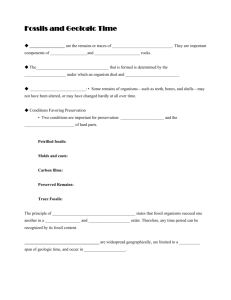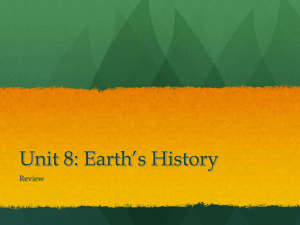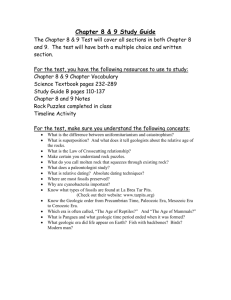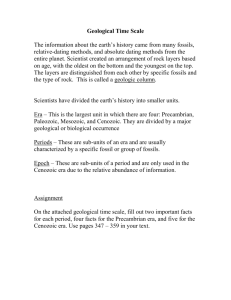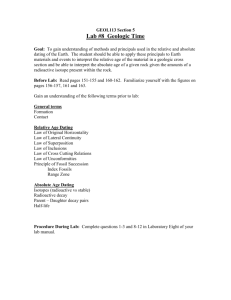The Rock Record
advertisement
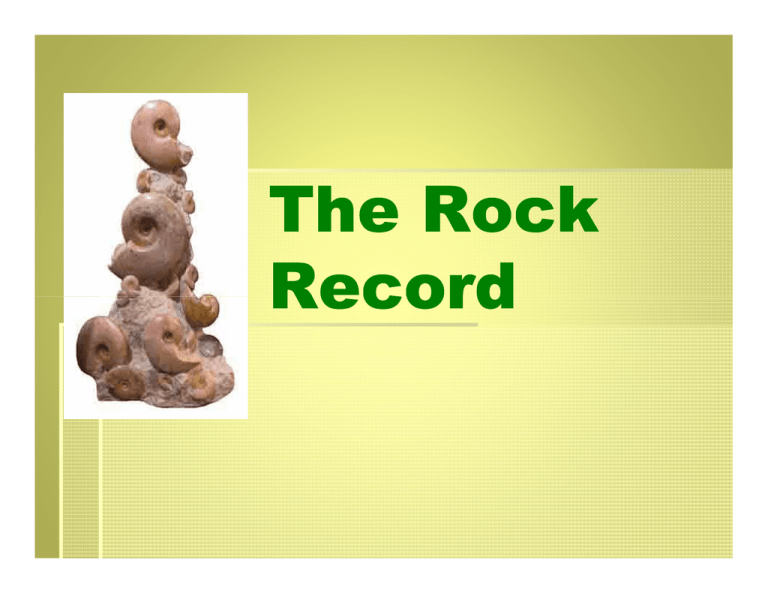
The Rock Record I. The ages of past events can be indicated in 2 ways: Relative Dating Absolute Dating A. Relative Dating Dating-- places events in a sequence, but does not give an actual age There are 3 laws associated with relative dating 1. Law of SuperpositionSuperpositionin sequences of undisturbed sedimentary rock the oldest rock is on the bottom and the youngest rock is on the top What happened here? 2. Law of crosscross-cutting relationships-relationships igneous intrusions are younger than the rock in which they are found. 3. Law of included fragmentsfragmentspieces of rocks found within another rock must be older than the rock in which they were found 4. UnconformitiesUnconformitiesPlaces in rock strata where layers are missing. Can you find the unconformities in the picture? B. Absolute DatingDatingprovides the age of an artifact 1. Counting tree ringsringsa. Each ring = 1 year b. The width of the ring depends on the temp & rainfall that year. How old is this tree? 2. Observing VarvesVarves- sediments that show a yearly cycle a. b. Ice from glaciers melts in spring and carries sediments that deposit in lakes You get a layer of new and old soil to represent 1 year. 3. Radioactive element decaydecay- the process of energy emission from an atom a. Radioactive isotopeisotope- atom that gives off radiation from its nucleus, or “decays” at a fixed, measurable rate b.Half b. Half--life life-- the time it takes for half of the atoms of a radioactive isotope to decay to a stable end product c. Decay rates are assumed to be unaffected by time or changes in temp & pressure. 4. Common radioactive isotopes a. Uranium Uranium--238 (U(U-238) 1. has a half life of 4.5 billion years 2. decays to LeadLead-206 (Pb(Pb-206) 3. Can only be used on some igneous rocks 4. Most reliable if rocks are less than 10 million years old b. Radiocarbon (C(C-14) 1. HalfHalf-life=5,700 years 2. Decays to CC-12 3. Can ONLY be used to find the age of things that were once living c. PotassiumPotassium-40 (K(K-40) 1. HalfHalf-life = 1.3 billion years 2. Decays to ArgonArgon-40 (Ar(Ar-40) 3. Is more common and can be used on all 3 types of rocks. Example: Ur-238 decay Years (billions) 0 4.5 9 13.5 18 22.5 UrUr-238 (g) 1000 500 250 125 62.5 31.25 PbPb-206 (g) 0 500 750 875 937.5 968.75 II. Geologic Time A. The Eras 1. Precambrian 2. Paleozoic 3. Mesozoic 4. Cenozoic 1. 1.Precambrian Precambrian EraEraa. Makes up 87% of Earth’s history b. First life appeared 2. Paleozoic Era a. Rise of: 1. marine invertebrates 2. fish 3. amphibians 4. reptiles 3. Mesozoic a. The era of the dinosaur b. Has 3 periods 1. Triassic: 1st dinosaurs 2. Jurassic: height of the dinosaur 3. Cretaceous: extinction 4. Cenozoic Era a. The Era of mammals b. Video c. At the end we see the planetary spread of Homo sapiens II. Fossils as Evidence for Evolution A.Evolution A.Evolution-change over time (Darwin’s Origin of Species, Species, 1859) B.Evolution B. Evolution is driven by natural selectionselection- organisms who survive to reproduce are those who inherited the most beneficial traits for surviving in a particular environment Darwin’s Story HMS BEAGLE The Galapagos Finches The Evolution of Man Scopes Monkey Trial: John Scopes prosecuted by William Jennings Bryan in 1925 C. Finding Rock correlations 1. When you find correlations, you match rock layers from 1 area to another 2. Look for similar appearance, color, composition & fossils 3. Index fossilsfossilscommon, easily recognized fossils that are typical of a particular time in history 4. Key bedbedsimilar to an index fossil, but covers a large area The End!!!!!!!!
